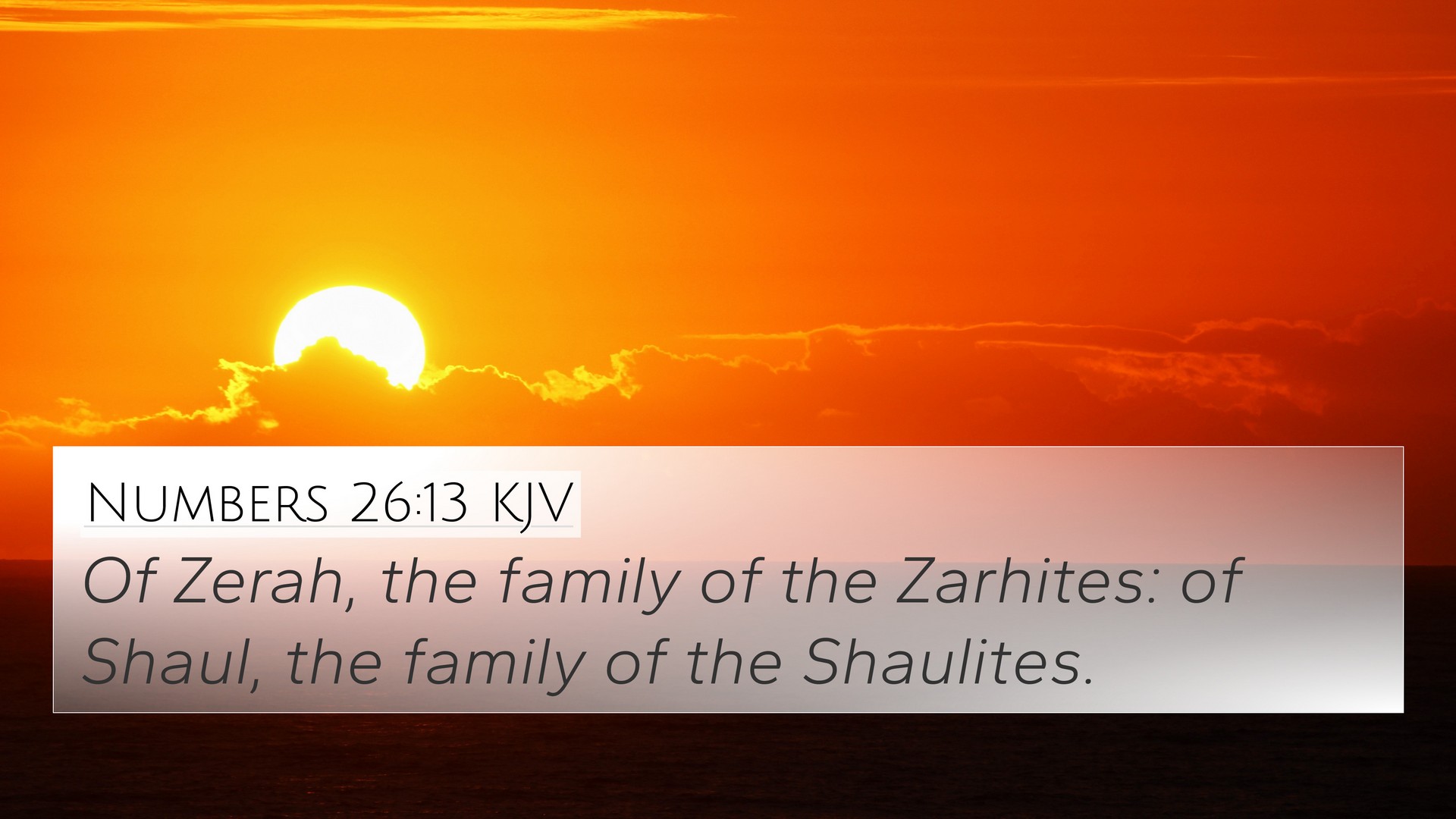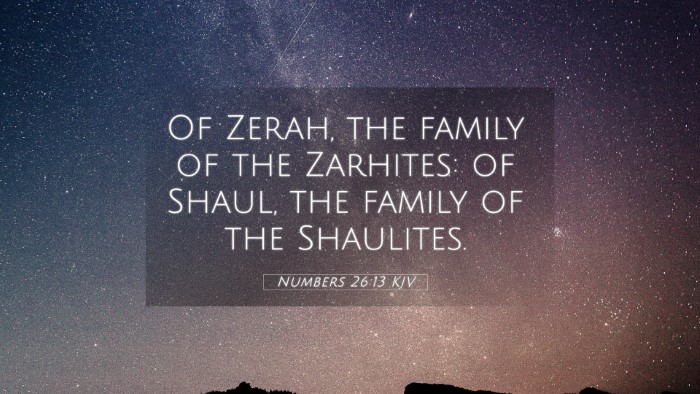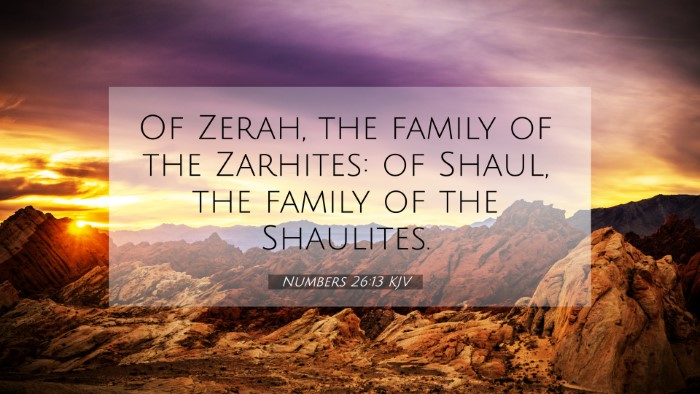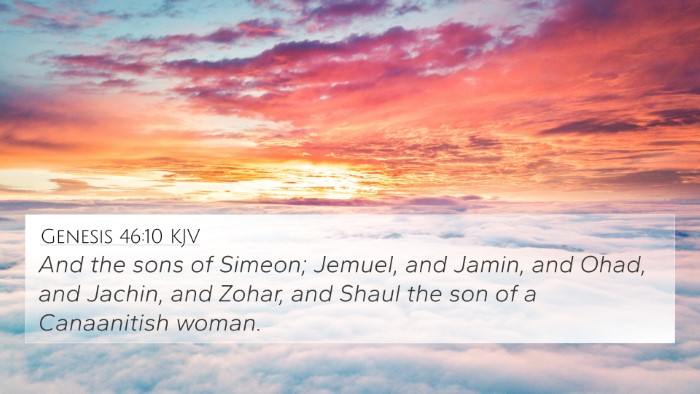Understanding Numbers 26:13
Numbers 26:13 states, “And the sons of Zebulun after their families were of Sered, and Elon, and Jahleel.” This verse continues the census of the Israelites, emphasizing the lineage and tribal affiliations that were crucial for land inheritance and governance in Israel.
Summary of Biblical Significance
This verse illustrates the importance of tribal identity and family lineage within the Israelite community. It serves as a record of God's faithfulness to His covenant, ensuring that each tribe is accounted for and will receive their appointed inheritance in the Promised Land.
Insights from Commentaries
-
Matthew Henry:
Henry emphasizes the significance of genealogy in Scripture, noting that every individual and tribe plays a pivotal role in the unfolding plan of God. The mention of the sons of Zebulun indicates the continuation of God’s promise to this family, affirming their place among God's chosen people.
-
Albert Barnes:
Barnes discusses how this census highlights God's order and structure within the Israelite society. The specifics of the tribes illustrate how God preserves His people and provides for them through their divisions, ensuring that their heritage remains intact.
-
Adam Clarke:
Clarke notes the historical context of the verse, explaining that the generations of Zebulun reflect not only the names of the descendants but also their character and futures as ordained by God. This attention to detail demonstrates the value God places on communal identity and righteousness.
Bible Verse Cross-References
In studying Numbers 26:13, we can identify several cross-references that illuminate this scripture further:
- Genesis 49:13: This verse refers to the blessings of Jacob upon his sons, including Zebulun’s future and territory.
- Joshua 19:10: This passage discusses the allotment of territory for the tribe of Zebulun, as promised.
- Deuteronomy 33:18-19: Moses’s blessings include Zebulun, affirming their role in driving nations and gathering spoils.
- 1 Chronicles 12:33: This verse highlights the mighty men of Zebulun, known for their skill in warfare, linking their valor back to this familial line.
- Matthew 4:13-16: Zebulun is mentioned in the context of prophecy fulfillment when Jesus began His ministry in the Galilee region.
- Luke 2:36-38: This passage narrates the presence of Anna, from the tribe of Asher, linking the prophetic heritage of the tribes.
- Revelation 7:8: Zebulun is included in the listing of the tribes of Israel, reaffirming their eternal significance in biblical prophecy.
Connections Between Bible Verses
By examining the connections between these verses, we can see:
- How the physical inheritance of land in the Old Testament reflects spiritual inheritance in the New Testament.
- The continuity of God’s covenant promises from the patriarchs to the New Covenant established by Christ.
- The representation of the tribes in both historical and eschatological contexts, affirming God’s overarching plan for humanity.
Thematic Bible Verse Connections
This verse can be examined through various themes:
- Genealogy and Covenant: Reflects the significance of family and heritage in God’s promises.
- Identity of God’s People: Showcases how God preserves and defines His people through lineage.
- Faithfulness of God: This census denotes God's continued support and guidance throughout generations.
How to Use Bible Cross-References
Using a Bible cross-reference guide can enhance your understanding. Here are some methods:
- Bible concordance: Use this resource to find verses with shared keywords.
- Bible reference resources: Consult thematic studies or books that outline connections between verses.
- Cross-referencing Bible study methods: Engage in group studies, discussing verses and their relationships for deeper understanding.
Inter-Biblical Dialogue
Engaging in inter-Biblical dialogue helps in uncovering the extensive narrative fabric of the Scriptures:
- Identifying connections between the Old and New Testaments sheds light on the continuity of God's purpose.
- Examining the prophetic insights in the Old Testament that find fulfillment in New Testament events allows for a richer appreciation of Scripture.
- Exploring thematic links, such as the role of faith in the narratives of both tests, provides depth in spiritual understanding.
Bible Studies and Sermon Preparation
When preparing sermons or Bible studies, consider utilizing Bible cross-references for sermon preparation. This can reveal:
- Similarities and contrasts between biblical characters, enriching teaching contexts.
- Supportive verses that undergird the main message being conveyed.
- Thematic explorations that resonate with contemporary audiences.



